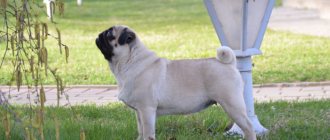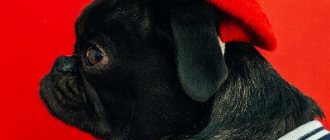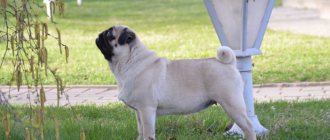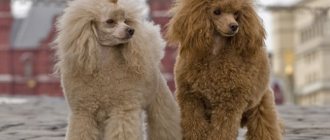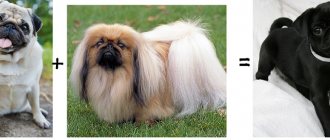A remarkable fact is that previously the color of a dog literally decided the matter of life and death. Beige pugs were the favorites of Chinese emperors and real darlings of fate. The dogs had their own servants, half tones were dedicated to them, they were presented as a sign of recognition.
Blacks were unlucky from birth: the appearance of such a puppy in a litter was considered a curse, for which they were mercilessly exterminated. Nowadays, the attitude towards colors is much simpler and almost each has its own admirers.
Standard and non-standard colors
The standard colors of this breed are beige, peach (or apricot) and black shades.
Owners of pets with coats of this color participate in exhibitions and can breed puppies with good pedigree. Not long ago, silver pugs were recognized as the breed standard, but not in all countries such dogs are recognized as “correct” and are allowed to participate in competitions.
However, even champion parents with excellent pedigree can produce unusually colored puppies. Therefore, the pedigree needs to be studied in more detail, because The color of the puppies depends on it.
It is a known fact that black pugs have a dominant gene, so in a pair of black and beige parents, puppies are always born black.
There can be many variations of shades; a few of the most memorable ones are highlighted.
White color
Dogs with completely white or very light hair and a black muzzle;
Beige color
The beige shade is the most common and is a recognized classic color. This is how most people imagine pugs.
Certain parameters apply to this shade:
- The color is light beige, calm, smoothly turning into a black “mask” on the muzzle;
- "Mask" is required! The fur around the eyes, nose and ears should be dark, almost black;
- The presence of a stripe of dark hairs on the back leading to the tail;
- Tail curl (even better, double);
- The eyes are brown. The darker it is, the more chances the dog has to take a prize.
Apricot (peach) color
The beige pug is often confused with its apricot (or peach) counterpart. It may be difficult for an inexperienced person to see this difference, however, the coat of the peach counterpart is slightly red in color, which changes the overall appearance of the dog. Pugs of this color, like black pugs, are quite rare, so they are valued higher. When evaluating pugs of this color, similar parameters are used.
Silver color
Silver pugs were recognized as the breed standard relatively recently, but in Russia only 3 standard shades are still recognized - black, beige, peach.
The silver pug has an amazing color - it is an ashy shade combined with light notes of beige.
Show standards allow for spots and moles on the forehead, black ears, and a dark stripe of fur on the back leading to a dark, almost black tail.
Albino Pugs
The dogs are completely white from head to tail;
Chocolate shade
Dogs with a solid dark brown coat, the color of which resembles milk or dark chocolate;
Tiger pugs
The color of the coat can vary from light beige to dark, the main feature being the stripes, like a tiger.
Steel color
The coat of such dogs is similar to silver, but there is a bright “steel” tint. This also includes gray pugs - they represent a transition from silver to steel shade.
Yellowish and fawn colors
They are so similar to breed standards (beige or peach) that it is almost impossible to see the difference in the photo, but due to differences in shades or unusual transitions, they are also not considered a standard.
Origin story
The Pug breed is quite ancient . The first mention of pugs dates back to the times of ancient China, where these dogs were favorites of emperors.
They were also bred by Tibetan monks; pugs were temple guards. It was from there that dogs were brought to Europe. Of all the breeds, pugs are the most mysterious; their appearance has been associated with various myths and legends.
Scientists today argue about their homeland.
Many say that the breed originated in the Far East, others think in Africa, and still others in Europe . Most are inclined to believe that they appeared in the East.
Pugs were mentioned in ancient Chinese manuscripts; there are even images of such dogs in jade and ceramic rosaries.
Pugs lived in the imperial palace and never left it; the dogs had a personal servant and a collar with a bell. This privileged position is explained by the fact that the supra-forehead folds resemble a Chinese character, which is why the folds on the pug’s forehead were called the imperial sign.
In China, there were two varieties of similar dogs, differing only in long hair, “Ha Pa” and “Lo Jie” . "Ha Pa" were long-haired. Most likely, the ancestors of pugs were “Lo Jie”, they looked like Pekingese, but had short hair.
In 1553, the pug came to France, then to the Netherlands, and from there the English king William of Orange brought them to England in 1689.
Empress Josephine, Napoleon's first wife, had a beloved pug named "Fortune".
Nowadays, many celebrities such as fashion designer Valentino and others keep pugs..
Color assessment at shows
Despite the fact that the color of a pug does not negatively affect its health, there are only 4 breed standards that allow participation in exhibitions:
- Beige.
- Peach.
- Black.
- Silver.
- Black color.
Black color is the rarest and most expensive. This is due to the fact that in China (this is where this breed of dog was bred) they did not favor black color, such wool was considered defective. Only a few centuries later, the British rehabilitated black pugs, considering their soft, shiny coat magnificent.
Despite the fact that black pugs are recognized as the breed standard, more stringent requirements are applied to them at exhibitions. A pitch dog should also have black claws, eyelids and eyes, and no light hairs should be visible in the fur (only a small white spot on the chest is acceptable, but when choosing, preference is given to a pure black dog).
Rare species
Most often you can find pugs of the following colors:
- yellowish;
- silver;
- beige;
- black.
Reference! Peach-colored pugs are considered the most expensive and rare at the moment.
Other colors are much less common. As a rule, such puppies quickly find their owners, although they are sold much more expensive than their counterparts. Connoisseurs of non-standard beauty are not deterred even by the fact that some colors are considered “culled”, as is the case with brindle color.
As for the most unusual colors, albinos are one of them. These are pure white dogs. Over the entire period, dog handlers have recorded less than ten cases of the birth of such puppies.
Care depending on color
The quality of wool is one of the fundamental factors leading to victory at the exhibition. She should be healthy and shiny. Each shade has its own individual characteristics.
The fur of black pugs is different from the fur of their counterparts of a different shade. It is smooth to the touch, like velvet, less thick. Another interesting feature is that black wool fades in the sun, so prolonged exposure to the scorching sun is not recommended. To maintain shine and gloss, you must use a special protective shampoo.
Dogs of this breed do not tolerate heat well, so in the hot summer you should refrain from long walks.
At first glance, it may seem that caring for the fur of pugs is easy; grooming is not necessary for them at all. But still, these are decorative short-haired dogs that shed a lot. Breeders recommend brushing them at least once a week, and during shedding - once every 2-3 days. You shouldn't give these dogs a full bath too often, once a month is enough.
Dogs of this breed are prone to allergies, so the choice of shampoo must be approached with special care. The shampoo is selected depending on the allergen - these dogs may be allergic to dust, grass or food.
Veterinarians and breeders recommend trying different brands of products to find the best option for each pet, but in general they agree that shampoo should be hypoallergenic.
Breed standard
The pug is a compact, square build. Its proportions in width and height are almost the same.
In the standard, the optimal height for females is 25-30.5 cm, for males 30.5-33 cm, weight 7 kg:
- The bridge of the nose should be slightly pronounced, absolutely straight, not snub-nosed. The folds on the forehead are as symmetrical as possible, the nose is black (light is a big drawback).
- The eyes are large, protruding and widely set. The eyes should be in line with the nose. Light-colored eyes, eyes where the whites are clearly visible are disadvantages.
- The bite is a slight bite of the lower jaw forward, but the incisors should be straight.
- The thin, tight-fitting ears are divided into two “rose” shapes – small ears located above the head with the inner part visible, or “buttons” laid forward tightly pressed to the head.
- The neck is the optimal length, not too short and not too long.
- The body is short, strong with good muscles.
- Limbs straight, strong
- The tail is short and set high, curled into a ring.
- The coat is short, smooth and soft.
- Color: silver, apricot, beige and black. Light colors have a black mask and a stripe on the ridge.
Read more about pugs here.
What color pug is best?
These funny funny dogs are created to be loved and touched by them. Future owners should answer several questions before purchasing a puppy:
Is the dog expected to participate in exhibitions?
If the dog is adopted simply as a family pet, then the color of the coat does not matter at all. As a result of mixing pugs of different colors, puppies can turn out to be the most unusual colors - from albino to spotted, like Dalmatians.
Animals of unusual colors always evoke affection and genuine interest among lovers. This does not affect the dog’s health in any way and does not have any defects, but for a professional, a pug of a non-standard color is considered a defect.
For this reason, those dog breeders who plan to actively participate and, moreover, win in exhibitions, should choose pets of black, beige or peach shade, because... It is these 3 colors that are considered the breed standard.
Another point to take into account when buying a puppy is closely related to the first:
Is it planned to breed the dog further?
If not, then the color of the pet is unimportant. However, if you plan to seriously engage in breeding pugs, you need to buy a puppy of the “correct color”. Otherwise, as a result of mating with parents with a “non-standard” color, puppies will also be born defective, and it will no longer be possible to sell such a dog for a large sum.
However, when choosing a puppy, you should be extremely careful and buy them only from parents with a good pedigree from reliable and trusted breeders.
The peculiarity of this breed is that the color can change radically within a year and a half. Therefore, a funny “correct” puppy may, unexpectedly for its owners, grow into a “wrong” pug, for which all doors to exhibitions will be closed.
Briefly about the main thing
- Pugs are a rare combination of the charm of a decorative dog with the courage of a devoted dog.
- With a friendly and cheerful character, these dogs make wonderful companions and friends for the whole family.
- They, like little clowns, know how to sniff and grunt funny, and it costs them nothing to cheer up anyone, even the most gloomy person.
- When choosing a puppy, you need to remember that not all shades of pugs meet the breed standards; this may lead to exclusion or disqualification from competitions.
- However, even the most “wrong” dog will become a full-fledged member of the family and will love its owners with all its little heart.
